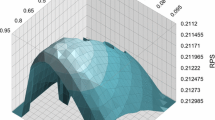Abstract
Singles tennis is one of the most popular individual sports in the world. Many researchers have embarked on a wide range of approaches to model a tennis match, using probabilistic modeling, or applying machine learning models to predict the outcome of matches. In this paper, we propose a novel approach based on network analysis to infer a surface-specific and time-varying score for professional tennis players and use it in addition to players’ statistics of previous matches to represent tennis match data. Using the resulting features, we apply advanced machine learning paradigms such as Multi-Output Regression and Learning Using Privileged Information, and compare the results with standard machine learning approaches. The models are trained and tested on more than 83,000 men’s singles tennis matches between the years 1991 and 2020. Evaluating the results shows the proposed methods provide more accurate predictions of tennis match outcome than classical approaches and outperform the existing methods in the literature and the current state-of-the-art models in tennis.
Access this chapter
Tax calculation will be finalised at checkout
Purchases are for personal use only
Similar content being viewed by others
Notes
References
Barnett, T., Pollard, G.: How the tennis court surface affects player performance and injuries. Med. Sci. Tennis 12(1), 34–37 (2007)
Biau, G., Scornet, E.: A random forest guided tour. Test 25(2), 197–227 (2016). https://doi.org/10.1007/s11749-016-0481-7
Borchani, H., Varando, G., Bielza, C., Larrañaga, P.: A survey on multi-output regression. Wiley Interdisc. Rev. Data Min. Knowl. Discovery 5(5), 216–233 (2015)
Breiman, L.: Random forests. Mach. Learn. 45(1), 5–32 (2001)
Breznik, K.: On the gender effects of handedness in professional tennis. J. Sports Sci. Med. 12(2), 346 (2013)
Brin, S., Page, L.: The anatomy of a large-scale hypertextual web search engine (1998)
Chen, T., Guestrin, C.: Xgboost: a scalable tree boosting system. In: Proceedings of the 22nd ACM SIGKDD International Conference on Knowledge Discovery and Data Mining, pp. 785–794 (2016)
Das, K., Samanta, S., Pal, M.: Study on centrality measures in social networks: a survey. Soc. Netw. Anal. Min. 8(1), 1–11 (2018). https://doi.org/10.1007/s13278-018-0493-2
Dingle, N., Knottenbelt, W., Spanias, D.: On the (Page) ranking of professional tennis players. In: Tribastone, M., Gilmore, S. (eds.) EPEW 2012. LNCS, vol. 7587, pp. 237–247. Springer, Heidelberg (2013). https://doi.org/10.1007/978-3-642-36781-6_17
Hastie, T., Tibshirani, R., Friedman, J.: The Elements of Statistical Learning: Data Mining, Inference, and Prediction. Springer, New York (2009)
Klaassen, F.J., Magnus, J.R.: Are points in tennis independent and identically distributed? evidence from a dynamic binary panel data model. J. Am. Stat. Assoc. 96(454), 500–509 (2001)
Klaassen, F.J., Magnus, J.R.: Forecasting the winner of a tennis match. Eur. J. Oper. Res. 148(2), 257–267 (2003)
Knottenbelt, W.J., Spanias, D., Madurska, A.M.: A common-opponent stochastic model for predicting the outcome of professional tennis matches. Comput. Math. Appl. 64(12), 3820–3827 (2012)
Levatić, J., Ceci, M., Kocev, D., Džeroski, S.: Semi-supervised learning for multi-target regression. In: Appice, A., Ceci, M., Loglisci, C., Manco, G., Masciari, E., Ras, Z.W. (eds.) NFMCP 2014. LNCS (LNAI), vol. 8983, pp. 3–18. Springer, Cham (2015). https://doi.org/10.1007/978-3-319-17876-9_1
Lundberg, S.M., Lee, S.I.: A unified approach to interpreting model predictions. In: Advances in Neural Information Processing Systems, pp. 4765–4774 (2017)
Ma, S.M., Liu, C.C., Tan, Y., Ma, S.C.: Winning matches in grand slam men’s singles: an analysis of player performance-related variables from 1991 to 2008. J. Sports Sci. 31(11), 1147–1155 (2013)
Michieli, U.: Complex network analysis of men single atp tennis matches. arXiv preprint arXiv:1804.08138 (2018)
O’Malley, A.J.: Probability formulas and statistical analysis in tennis. J. Quant. Anal. Sports 4(2), 1-23 (2008)
Page, L., Brin, S., Motwani, R., Winograd, T.: The pagerank citation ranking: Bringing order to the web. Technical Report, Stanford InfoLab (1999)
Peters, J.: Predicting the outcomes of professional tennis matches (2017)
Radicchi, F.: Who is the best player ever? a complex network analysis of the history of professional tennis. PLoS ONE 6(2), e17249 (2011)
Sipko, M., Knottenbelt, W.: Machine learning for the prediction of professional tennis matches. MEng computing-final year project, Imperial College London (2015)
Spyromitros-Xioufis, E., Tsoumakas, G., Groves, W., Vlahavas, I.: Multi-label classification methods for multi-target regression. arXiv:1211.6581 (2012)
Vapnik, V., Vashist, A.: A new learning paradigm: learning using privileged information. Neural Netw. 22(5–6), 544–557 (2009)
Wang, J., Chen, Z., Sun, K., Li, H., Deng, X.: Multi-target regression via target specific features. Knowl. Based Syst. 170, 70–78 (2019)
Author information
Authors and Affiliations
Corresponding author
Editor information
Editors and Affiliations
Rights and permissions
Copyright information
© 2021 Springer Nature Switzerland AG
About this paper
Cite this paper
Bayram, F., Garbarino, D., Barla, A. (2021). Predicting Tennis Match Outcomes with Network Analysis and Machine Learning. In: Bureš, T., et al. SOFSEM 2021: Theory and Practice of Computer Science. SOFSEM 2021. Lecture Notes in Computer Science(), vol 12607. Springer, Cham. https://doi.org/10.1007/978-3-030-67731-2_37
Download citation
DOI: https://doi.org/10.1007/978-3-030-67731-2_37
Published:
Publisher Name: Springer, Cham
Print ISBN: 978-3-030-67730-5
Online ISBN: 978-3-030-67731-2
eBook Packages: Computer ScienceComputer Science (R0)




